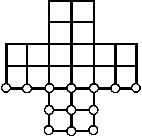As most people in the DAS will have noticed by now, I tend to enjoy the occasional board game during the evening’s banquet. Much, it could be said, as fish enjoy the occasional swim. I have decided therefore, to write up rules for some of the more common games from our period, thus allowing me in future to pester anyone at the banqueting table nearby for a game. This will probably come as a relief to Finn, who may be getting somewhat tired of seeing his platter and bowl swept away as I bring out my gaming board.
Whilst board games are mentioned in sagas and poems from the period, such mentions rarely if ever give us an idea as to how the game was actually played. The rules would also vary from place to place, as regional variants would almost certainly have developed as the game spread. The word tafl, Old Norse for ‘table’, usually forms part of the name of each game. For example; hnefatafl or ‘kings’ table’, hræðtafl or ‘quick table, etc.
Pieces were often hemispherical and made from such materials as bone, glass, clay, stone or even horses teeth. They were divided into sides by colour, usually one dark side and one light. King pieces were usually a different shape to distinguish them from the others.
Halatafl (Fox Table)
This game, more commonly known as ‘Fox and Geese’, is mentioned in the Icelandic Grettis Saga, which was written in the fourteenth century by an anonymous priest who lived in the north of the island.

The board used for this game is the same as a normal solitaire game. Thirteen ‘geese’ are placed on the board as shown, the ‘fox’ is then placed on any vacant space.
The fox moves one space at a time in any direction, except diagonally. Instead of a normal move, he can capture a goose by jumping over it, provided the space immediately behind it is empty. The geese move individually, one goose per turn, but may not jump over the fox to capture him. Instead they must pen him in so that he cannot move or jump. They are also forbidden to move backwards and lose if the fox is able to get behind them.

To me, halatafl demonstrates the problems of trying to recreate the original rules of such an old game. It will soon become plain to anyone who plays this game that the geese, if played sensibly, will always win. In fact they should do so without losing a single piece. Whilst it is not uncommon for games of this period to favour one side over the other, there is a reason why I think the original game was played with different rules. We know that the early sets consisted of thirteen geese and one fox, royal accounts of Edward IV (1461-83) mention two sets consisting of “two foxis and 26 hounds of silver overgilt.” However, shortly after 1600 four extra geese were added to the game, two each along the sides of the cross arms as shown below.
I find it hard to believe that players of the game were so inept as not to have noticed the ease with which the geese can win. Either different rules were used, which gave the fox more of an advantage, or people were getting fed up with someone saying; “Just give me one more go as the fox, I think I’ve got another idea…”
Merels or Nine Men’s Morris
This game is my favourite and probably the most commonly found board game from the period. It has been found on the backs of other game boards, on ship’s timbers, benches and even carved into rocks. Unfortunately we don’t know what title it had during our time period; the Latin name of Merels came into use shortly after Anglo-Saxon times. The board is marked out with three concentric squares, linked through the middle of each side.
The game is divided into three separate phases, although the aim in each phase is the same; to form a line of three of your men, known as a mill.

In the first phase each player takes it in turn to place one of their nine men onto the board, either on a corner or where two or more lines connect. If one player is able to form a mill then he may remove an opposing piece. This piece should not, if possible, be taken from an existing mill; any piece removed from the board is lost for the rest of the game.
When all pieces have been placed on the board, then the second phase of the game begins. Players take it in turn to move one of their men along the lines from one intersection or corner to an adjacent spot.
Pieces may not jump over others and if no man can be moved, then that player automatically loses. On completion of a mill then another opposing piece is taken as before. This continues until one player is left with only three men.
In the third and final phase a player with only three men may move one piece each turn to any empty point on the board. When a player is down to only two men, they have lost the ame.
In the above rules, there is nothing to stop a player forming a mill, moving a piece away and then moving it back again in subsequent moves. To make for a more strategic and interesting game players can agree to use the following extra rule. Before a mill can be reformed, at least two of the men in that mill have to be moved.
DARK AGE BOARD GAMES (part one of an occasional series by Valgard Ulriksonnr) – DASmag Spring 1999